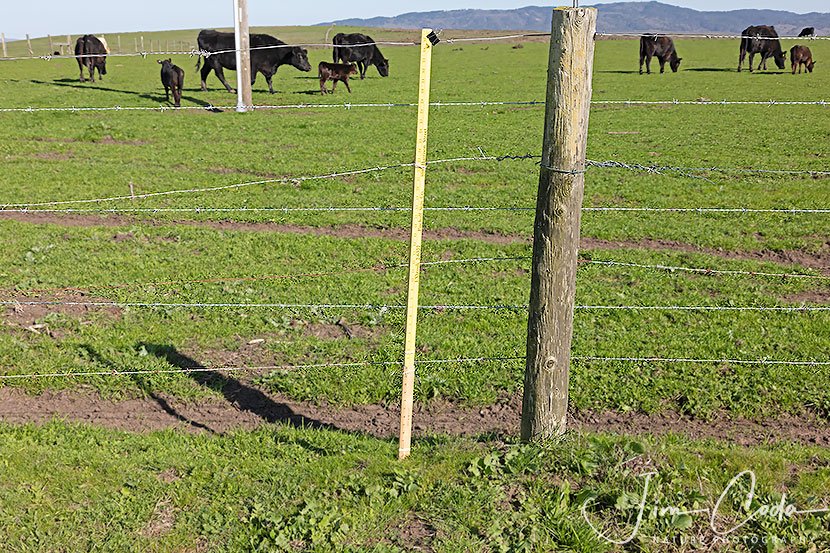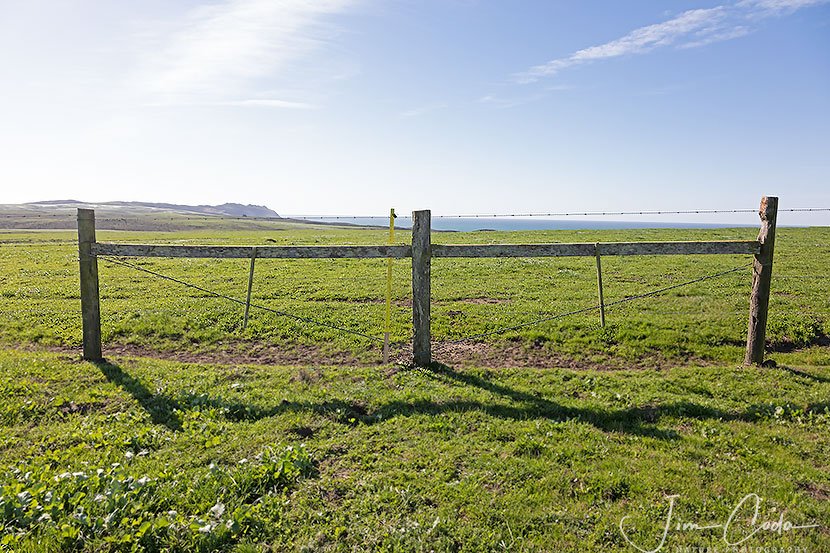Point Reyes; Fencing in Home Range of Drakes Beach Elk Herd Is NOT Wildlife-Friendly
A friend read my blog about the new fence along Sir Francis Drake Boulevard and sent me two photos. They showed a 7-strand barbed wire fence that looked very tall and there was very little space between the top two wires and between the bottom wire and the ground. He added that the fence was along Drakes Beach Road where the Drakes Beach elk herd exists. That was surprising and concerning to me. I had checked the fences throughout PRNS, including along Drakes Beach Road, for a fencing blog I wrote in 2014 (available here) and I never saw a 7-wire fence in Point Reyes then, let alone in a place so important to the wild free-roaming Drakes Beach elk herd.
So, the next day I went to investigate. Here’s what I found:

Good Example of a Fence on East Side of D Ranch that is Not Wildlife-Friendly
Before discussing the fence in the photo above, I want to point out that in its EIS for a new general management plan for the ranching area, NPS stated that it would follow wildlife-friendly fencing standards in managing the area. It adopted the specs of USDA’s Natural Resource Conservation Service (NRCS). The NRCS specs adopt “A Landowner’s Guide to Wildlife Friendly Fences: How to Build Fences with Wildlife in Mind.” First edition (2008). To view the NRCS specs/Landowner’s Guide, click here. It describes a wildlife-friendly fence as generally one that allows animals to jump over or crawl under it without injury. Page 8. More specifically:
- The top wire should be low enough for adult animals to jump over, preferably 40 inches, and “absolutely no more than 42 inches.” Id.
- The distance between the top two wires should be “[a]t least 12 inches,” so elk and deer won’t tangle their back legs with the top wires; Id. (For a photo showing what happens if the top two wires are not far enough apart, click here. It’s called “scissoring.”)
- The bottom wire should be “at least 18 inches,” above the ground. Id.
- The top and bottom strands should be “smooth wire” (like regular two strand twisted barbed wire, but without the added barbs) so animals don’t get snagged and injured. Id.
- No vertical stays. Id.
Finally, the top wire should be made highly visible so mammals and birds see it when running or flying by using high visibility wire or sections of white pvc pipe, flagging or a top rail. Id.
How does the above fence stack up against the wildlife-friendly fence specs? Not very well. The fence is 47 inches high and there is only a clearance of 6 inches between the two top wires. The top wire should no more than 42 inches high and, preferably, only 40 inches high. The clearance between the two top wires should be at least 12 inches to prevent scissoring. The bottom wire is a little over 12 inches above ground and it should be 18 inches. The top and bottom wires should be smooth and the top wire needs to be made more visible. Starting from the top, it looks like the second, fourth and sixth wires are new and taut and the first, third, fifth and bottom wires are old, rusted and not taut. It seems like it was partially replaced recently.
As was evident in my previous article about new fencing along Sir Francis Drake Boulevard, NPS doesn’t seem too enamored with wildlife-friendly fencing. It didn’t follow it there. Furthermore, in the EIS NPS said wildlife-friendly fencing would only be used when new or replacement fences are built. Finally, it said only 20% of existing fencing would be replaced in the next 20 years. That’s 1% (3.4 miles) of 340 miles of existing fencing per year. Obviously, making fencing wildlife-friendly is not a high priority for the Park Service at Point Reyes.
However, the FEIS Appendix also states as follows: “While all new Fencing would be required to be wildlife friendly, the EIS does not require that existing fencing be changed until it needs to be replaced because replacing all fencing would be cost prohibitive. NPS would work with ranchers as needed to make adjustments to fences that pose a threat to wildlife. In areas where elk occur, fences would be repaired and/or replaced with wildlife-friendly fence designs that reduce the extent of damage by elk, and as existing fencing is replaced, it would be replaced with wildlife-friendly Fencing.” FEIS, Appendix at P-42. (Emphasis added.)
This fence certainly poses “a threat to wildlife.” It’s also in an area “where elk occur” so it should be, without doubt, a very high priority for NPS to make wildlife-friendly. The same should apply to the entire stretch of fencing along both sides of the road to Drakes Beach because the elk cross the road for its entire length and not one part of it is wildlife-friendly. Furthermore, NPS has a statutory duty to protect and preserve wildlife and the existing fencing along Drakes Beach Road is a threat to that wildlife. This actually applies to all fencing at Point Reyes (and Golden Gate NRA) because deer and elk exist all over and none of the fencing is wildlife-friendly.
About 10 years ago, NPS modified two or three sections of the fencing on each side of Drakes Beach Road to provide the elk some spots where they could clear the fence easily. This was for the benefit of the A and C Ranches who have grazing privileges there and who often complained of the cost of repair for broken fence wires (that were broken because they were kept too high). It was also of benefit to the elk by reducing injuries to them when they jump the wildlife-unfriendly fences on both sides of the road.

Wildlife-Friendly Fence Undone by C Ranch
I mentioned these lowered fences in my 2014 blog about the fencing at Point Reyes being so unfriendly to wildlife with these few exceptions for the elk along Drakes Beach Road. Well, as the photo above shows, the ranchers didn’t like making it easier for the elk to jump the fences even if it reduced their need to repair fence wires because they don’t want any elk eating any grass on the lands they have subsidized permits for. So, they ignored NPS’s attempt to do a good thing and strung wire at a height that would cause elk problems. In the photo above, the top of the board is 37.5 inches. That was how NPS had modified the fence so elk could clear it easily and safely. The C Ranch added a barbed (not smooth) wire. That wire is 45.5 inches high. Due to the distance and lighting, the rest of the wires are difficult to see, but there are two additional wires (not counting the angled tension wires) plus the board. The lowest wire is at 18 inches. In summary, this spot is no longer easy for elk to jump and the rancher can continue to complain about the elk damaging the fences on his side of the road because the entire fence run is wildlife-unfriendly. I noticed the other spots along Drakes Beach Road where NPS had removed the top wire and replaced it by a board lower down were also all changed by the two ranchers.
NPS never did anything about what the ranchers did to undo NPS’s attempt to reduce elk problems with the fences. NPS should immediately convert the new Sir Francis Drake Boulevard section of fencing that I wrote about recently, and this fencing along both sides of Drakes Beach Road, to be wildlife-friendly. Then, it should do the same with all other fencing in the two parks and complete the work in no more than twelve months.
